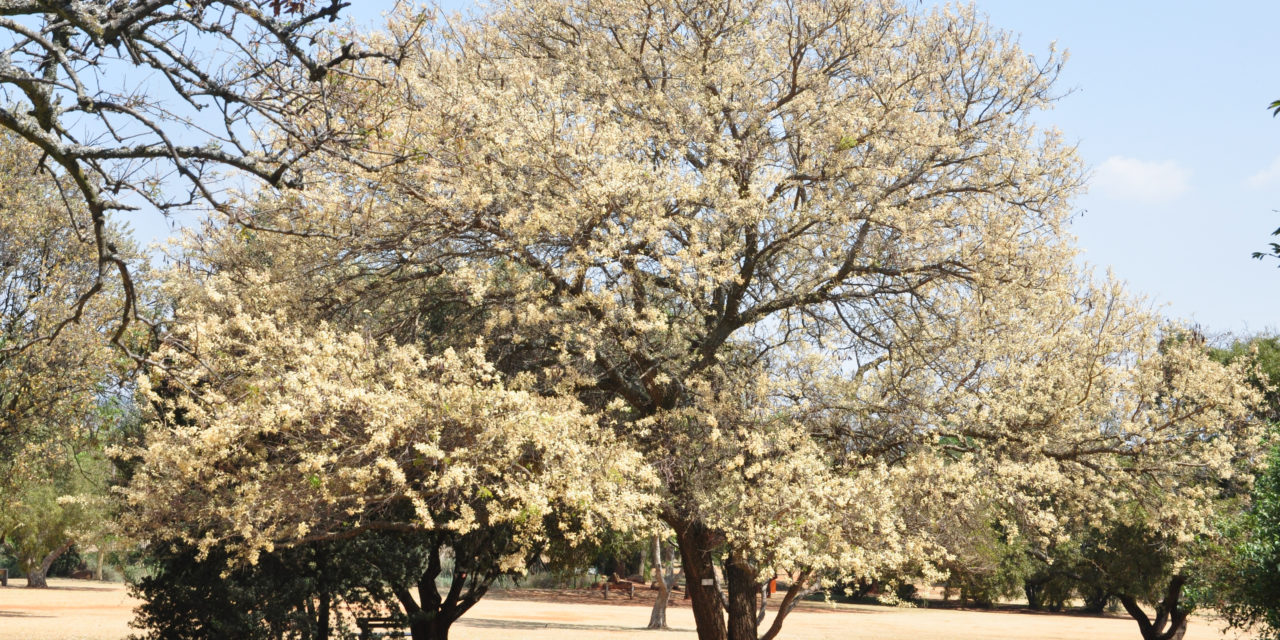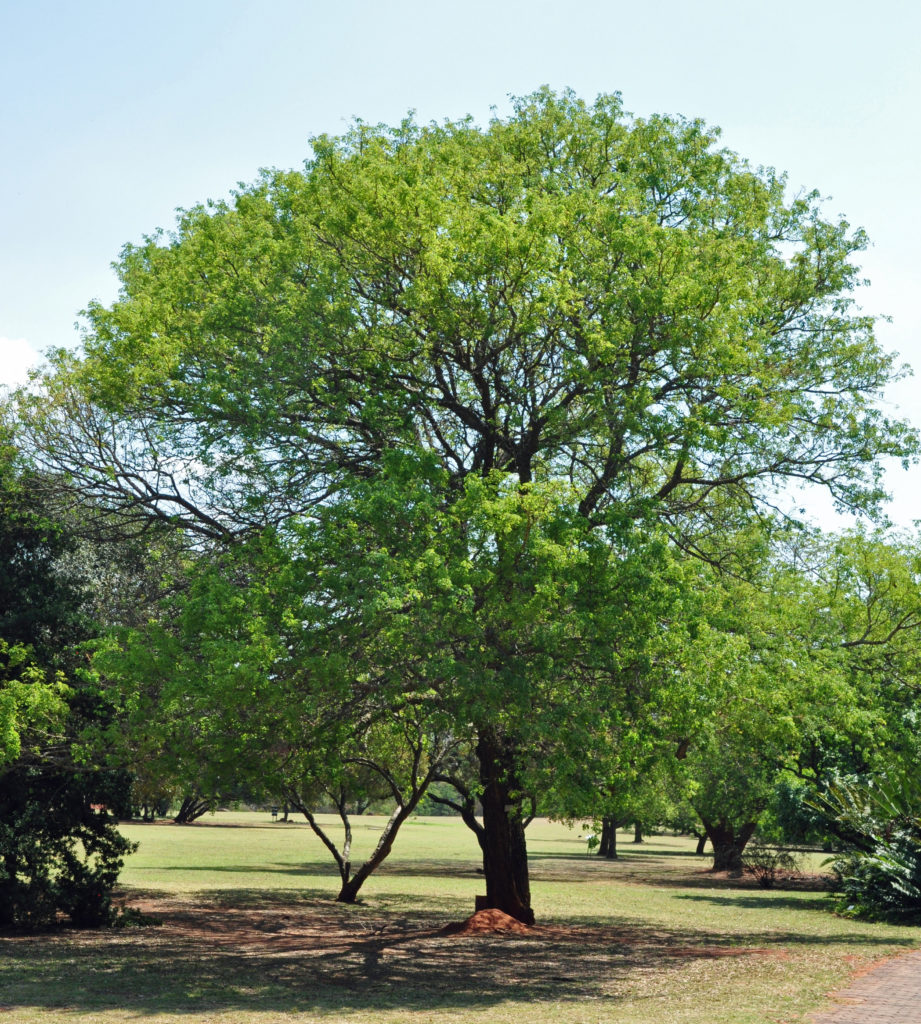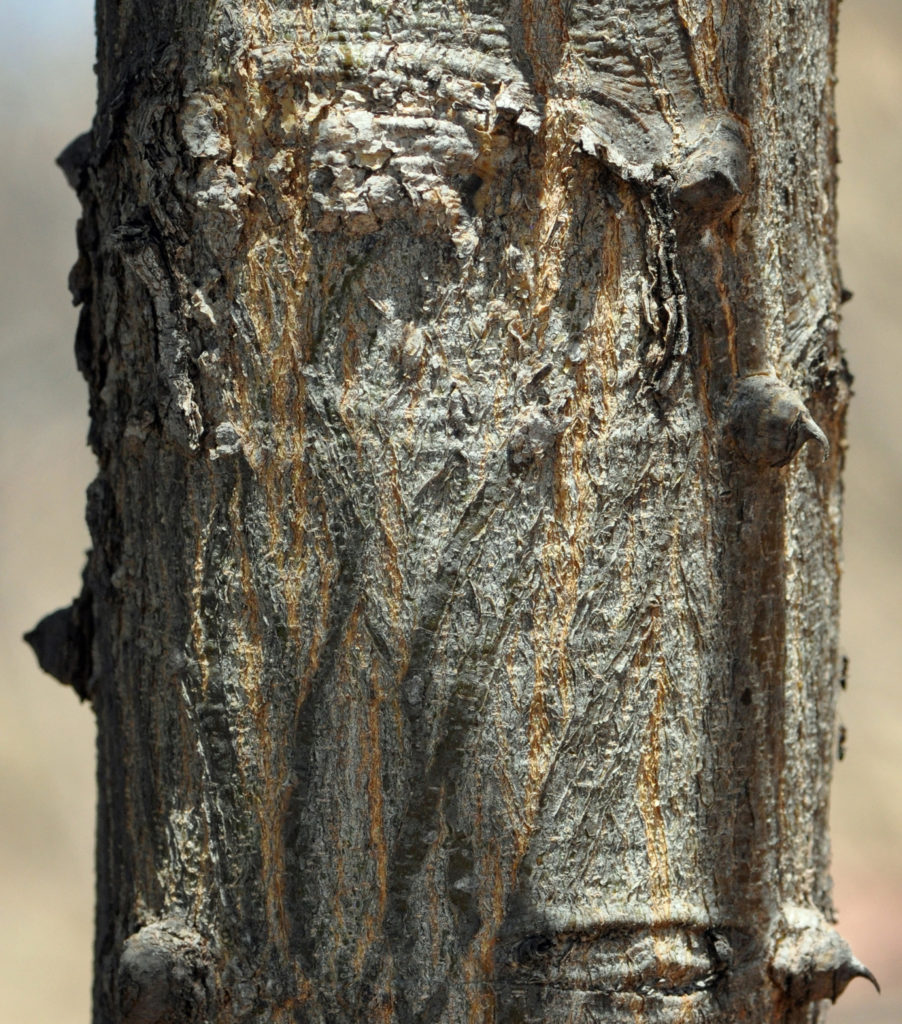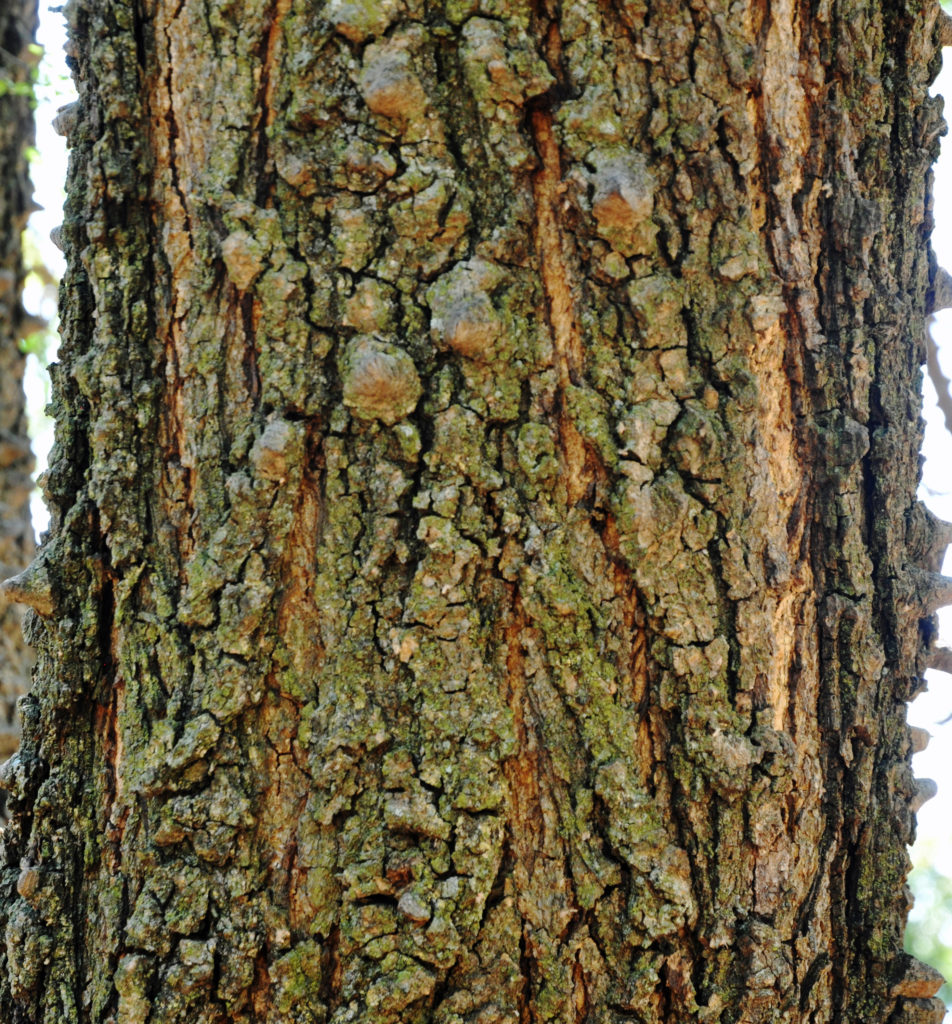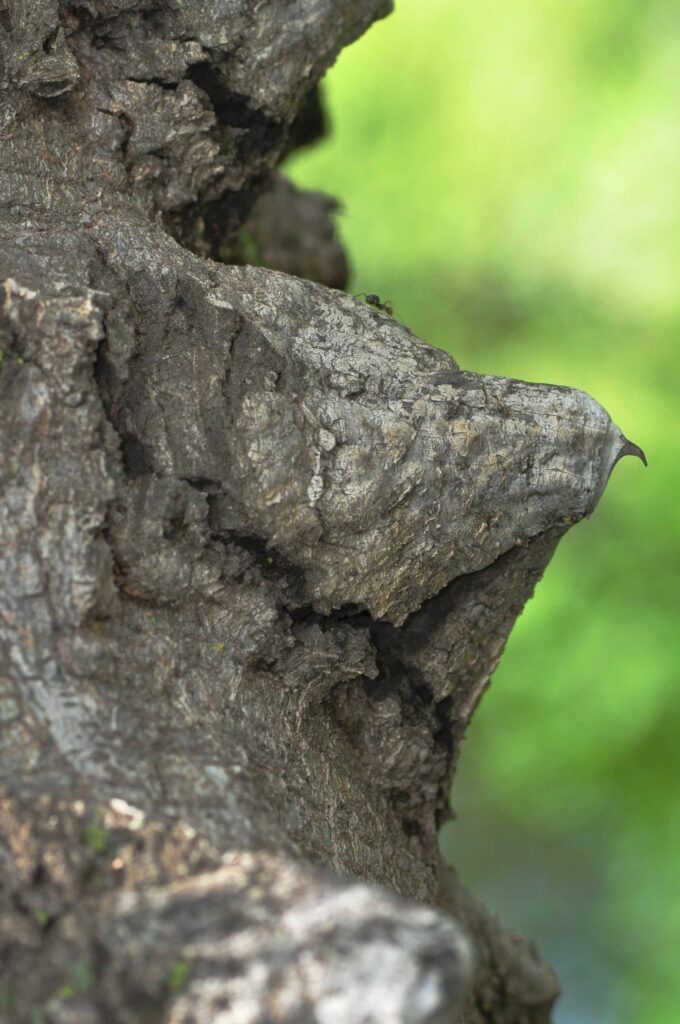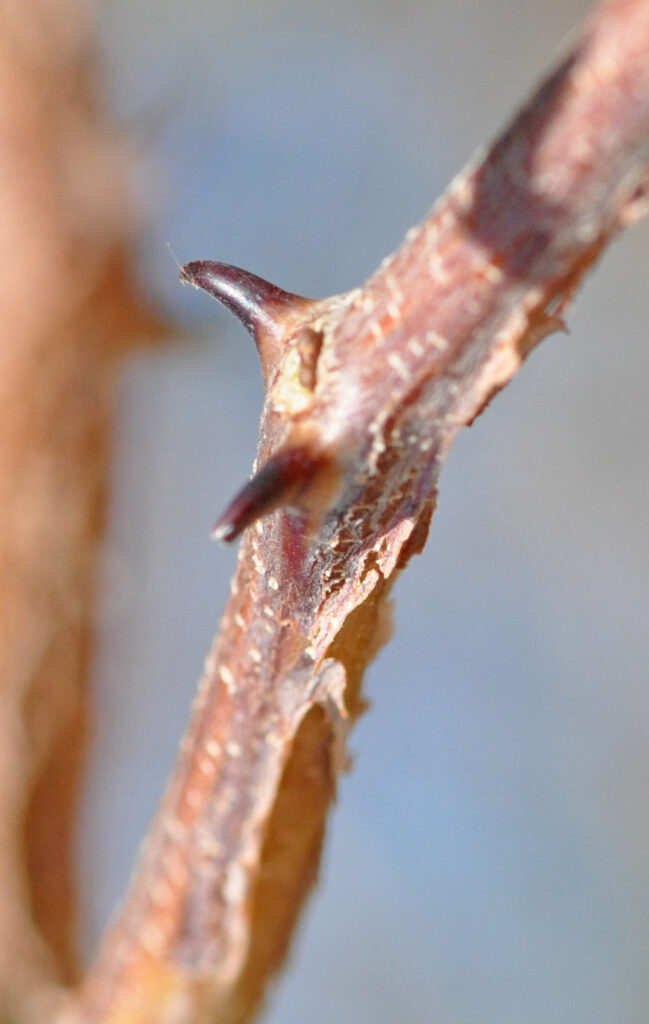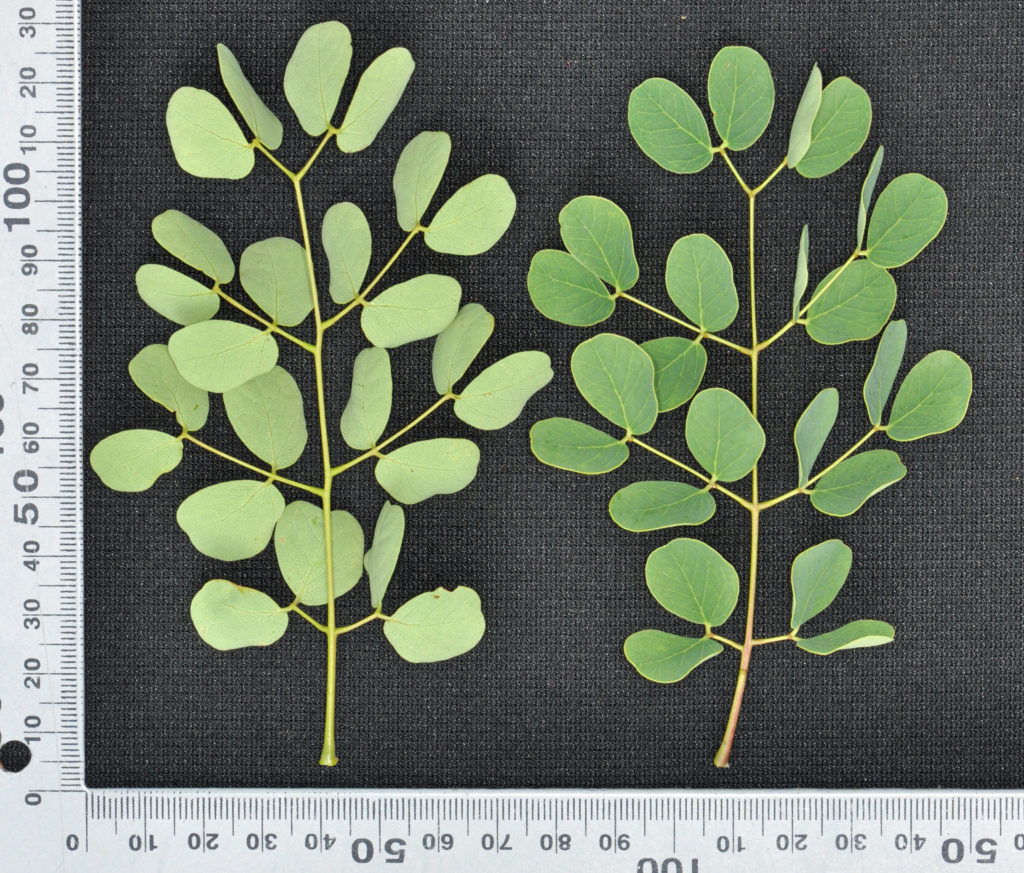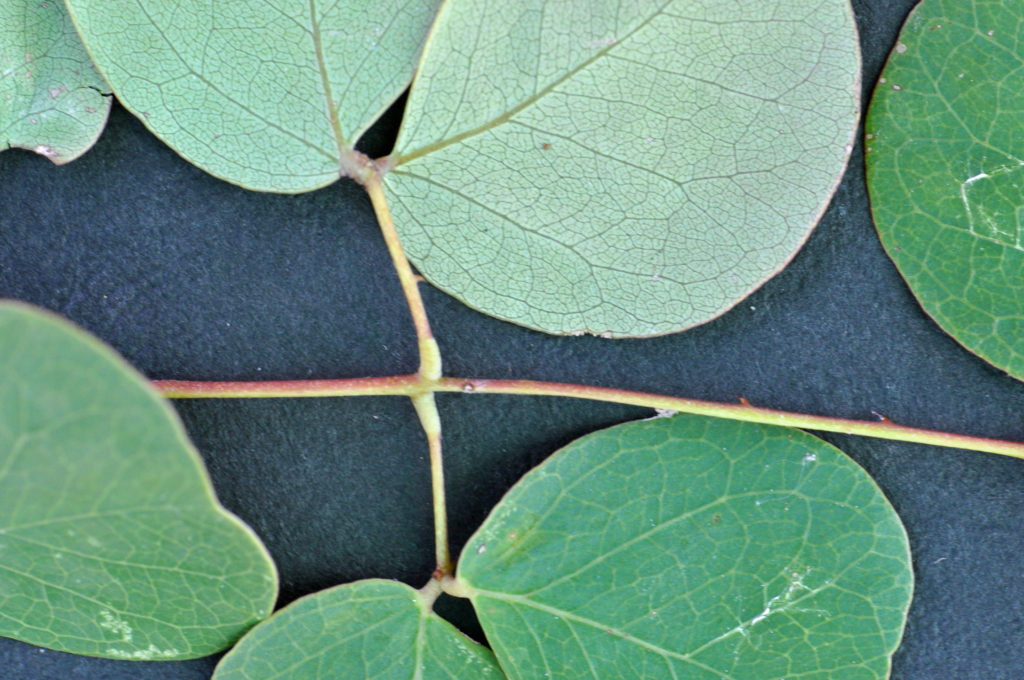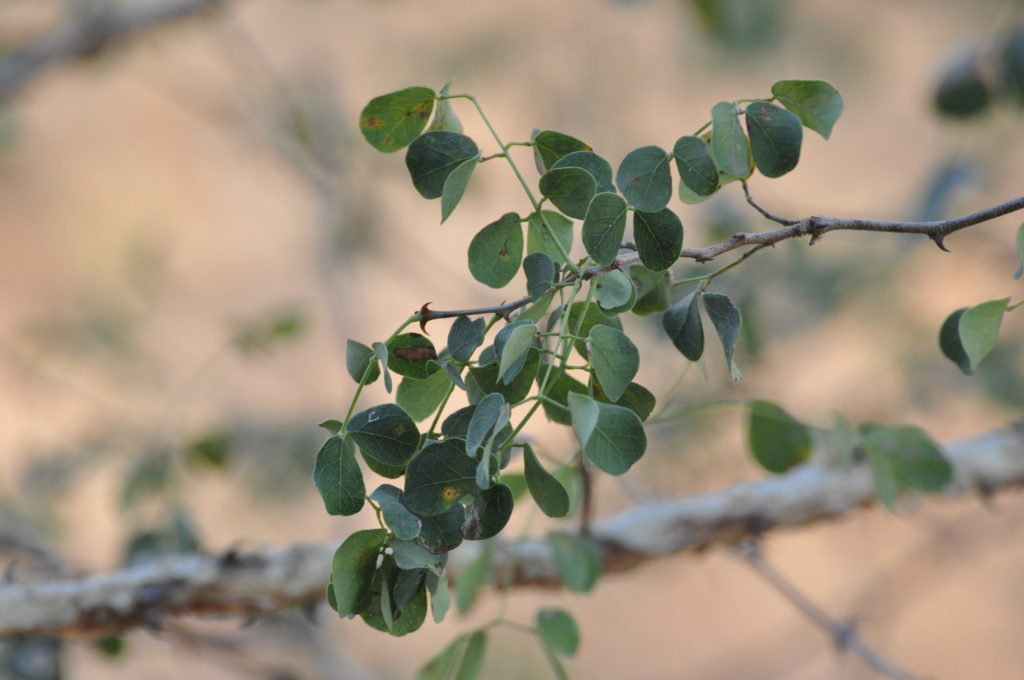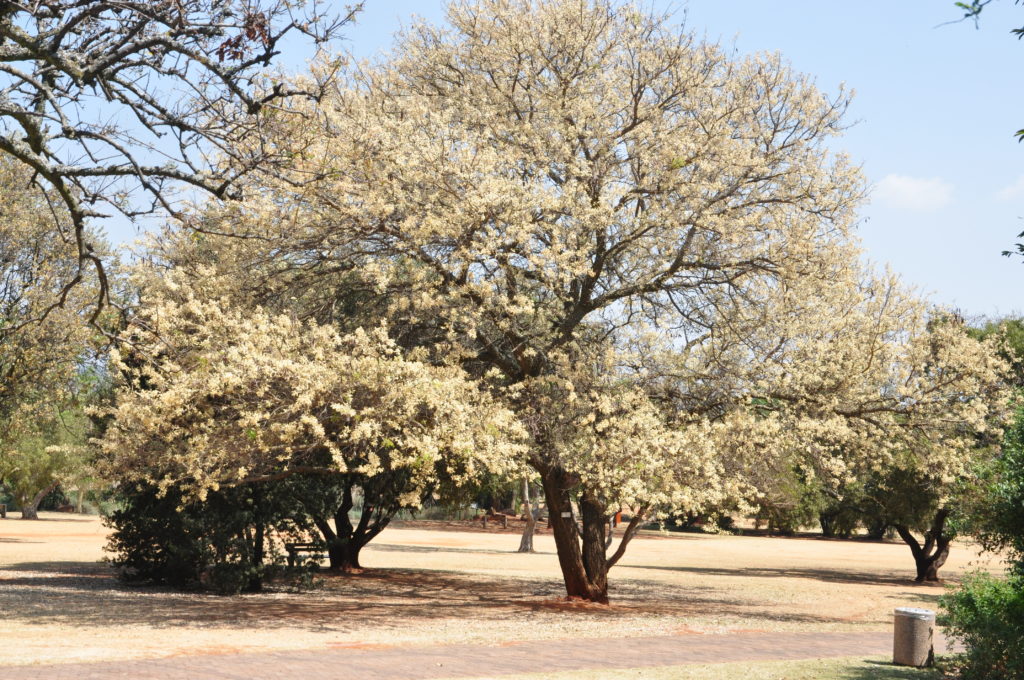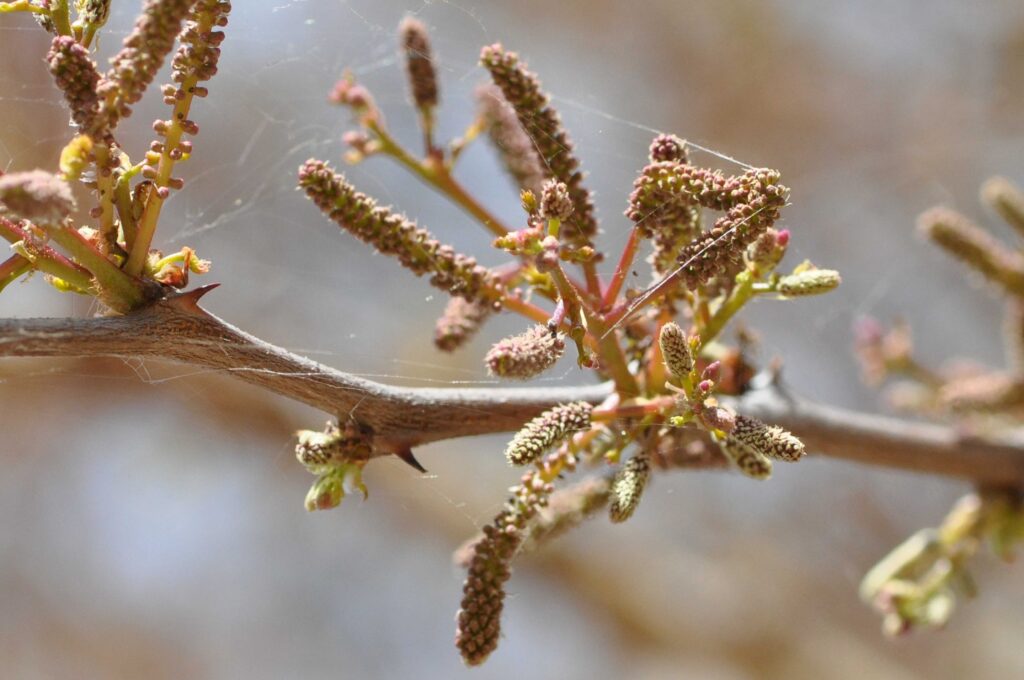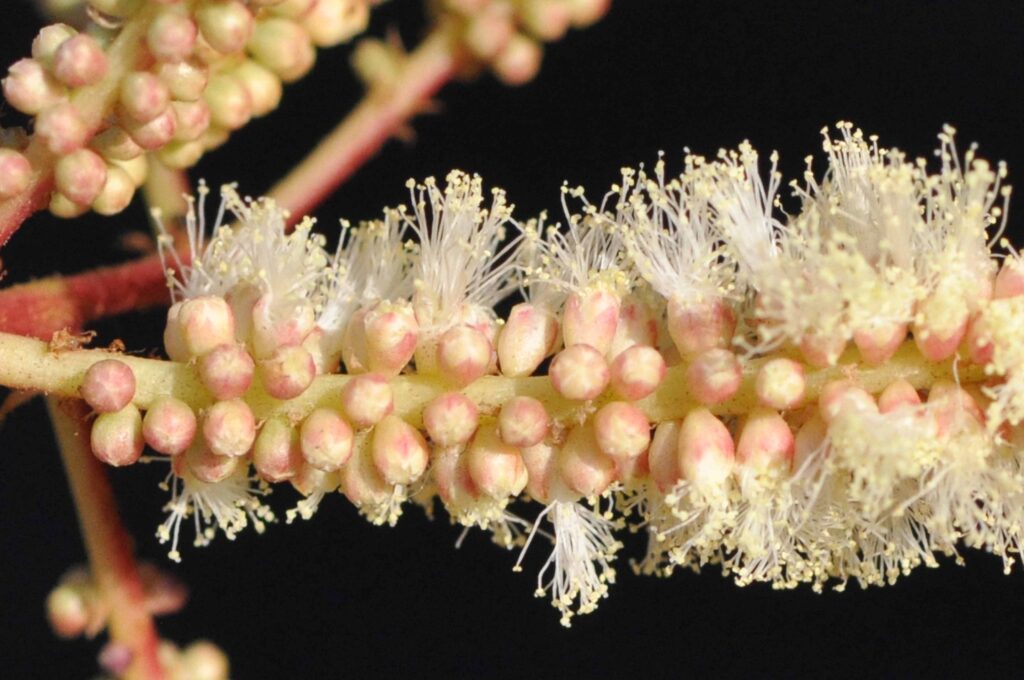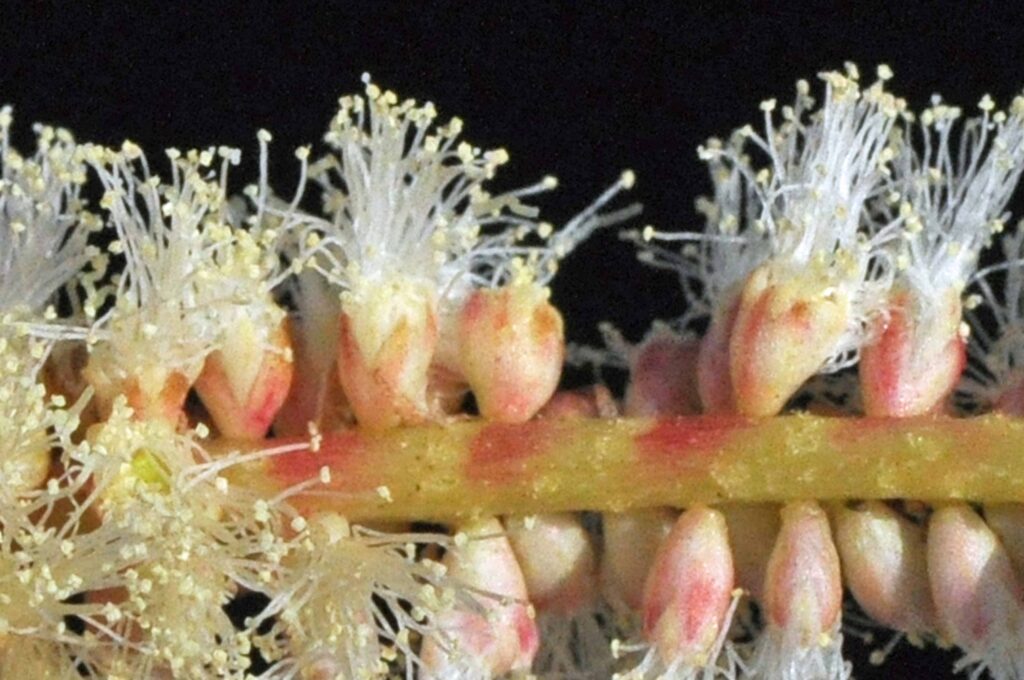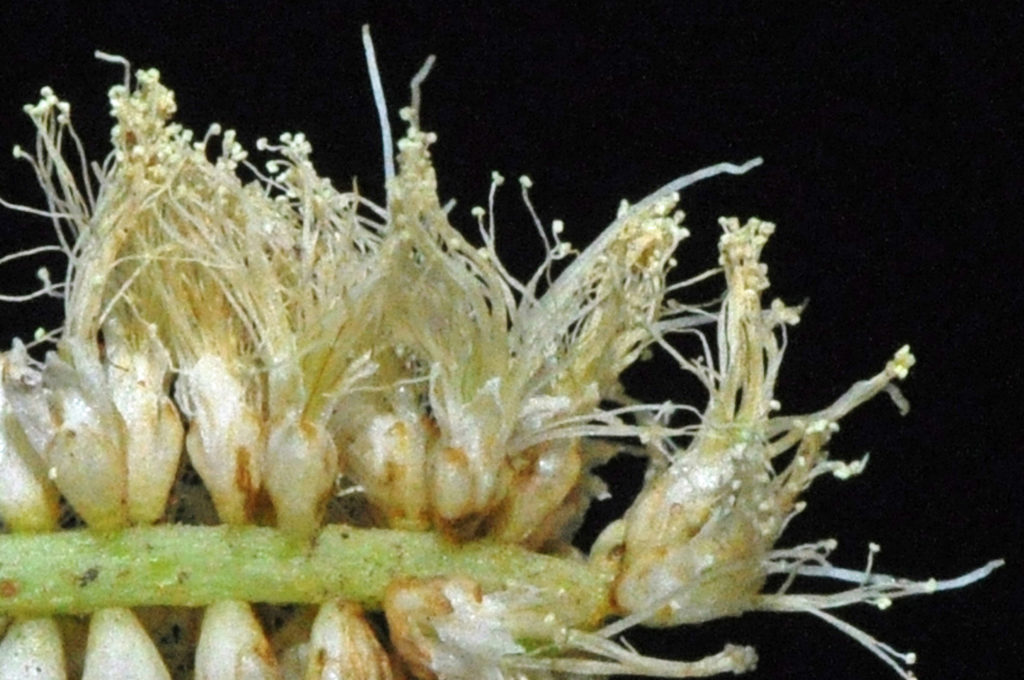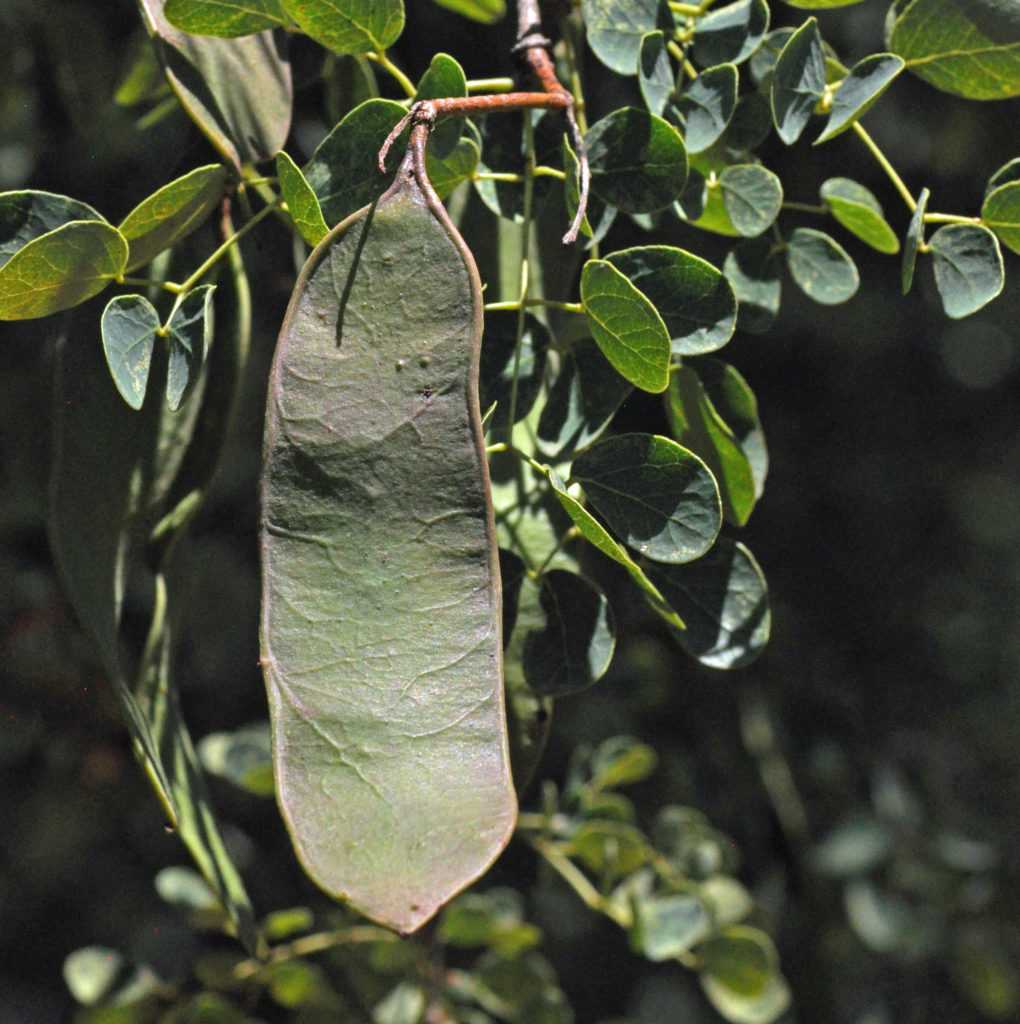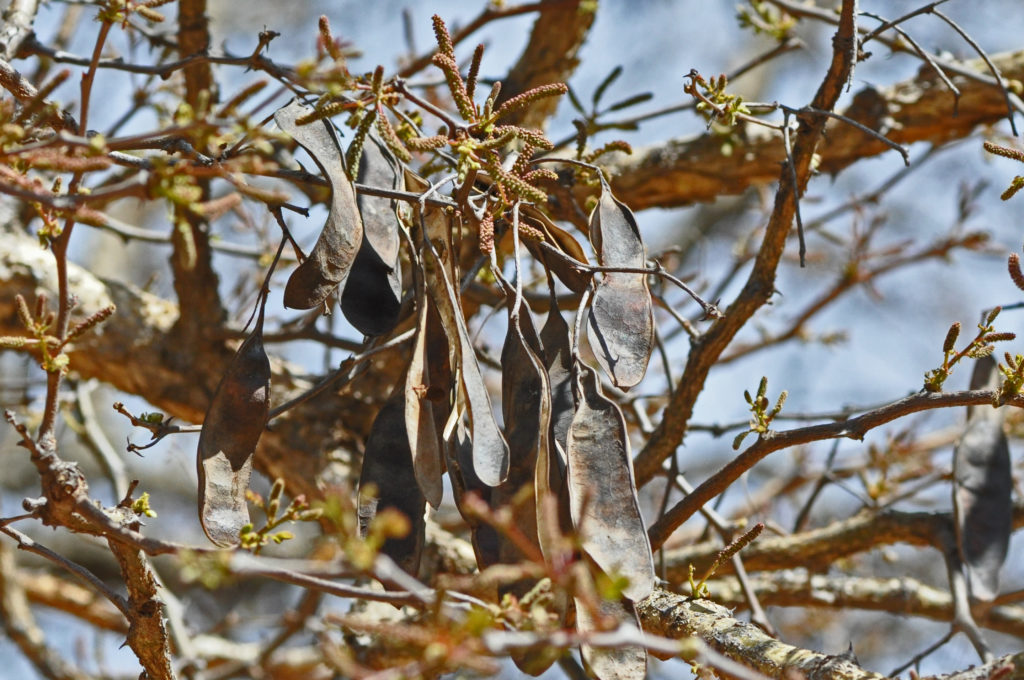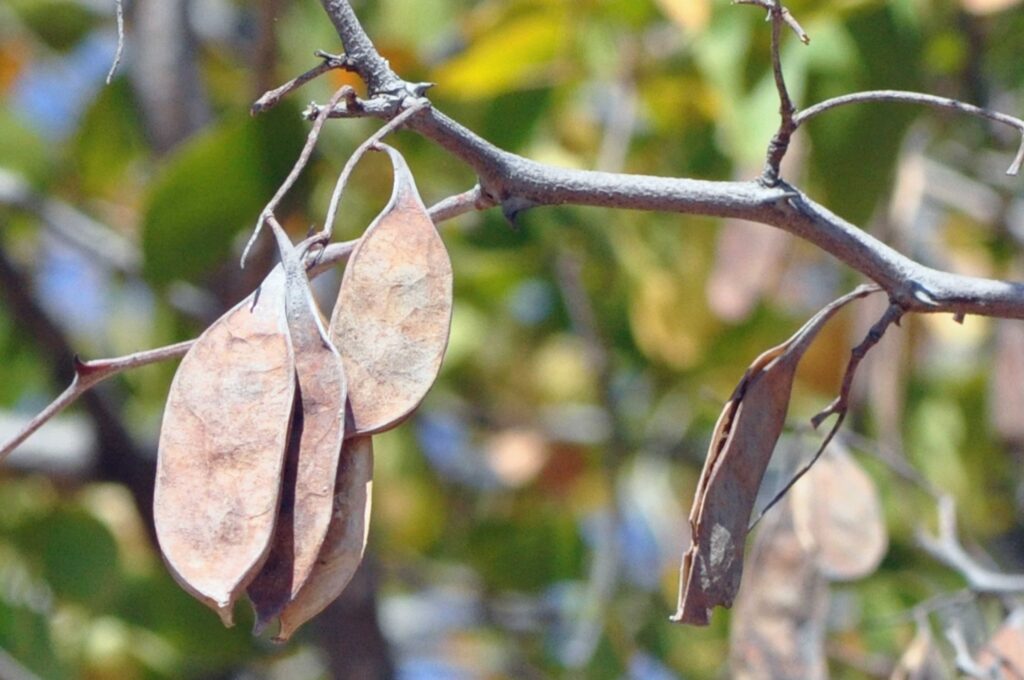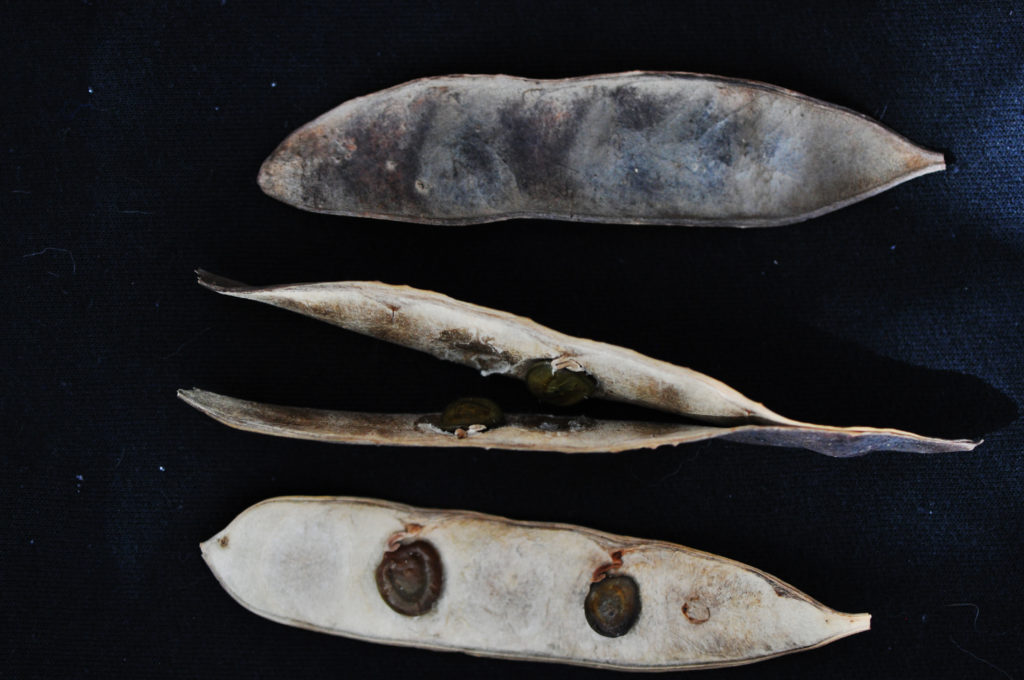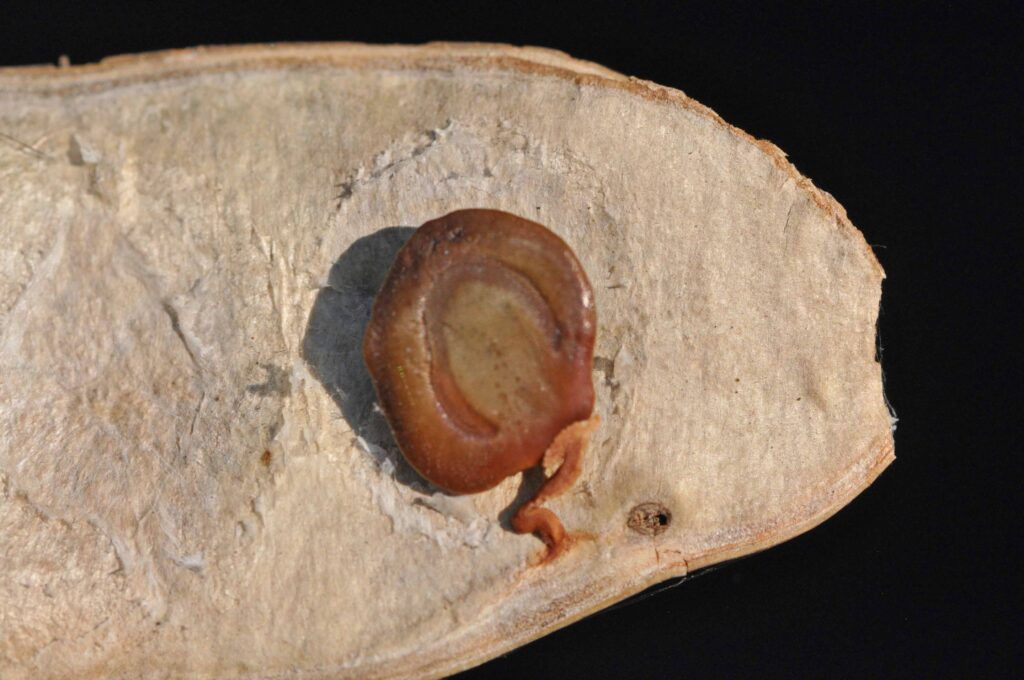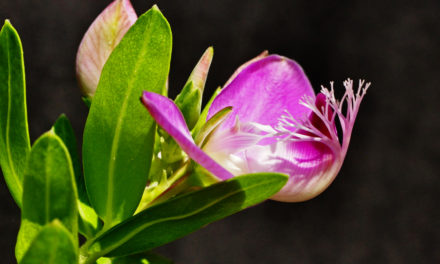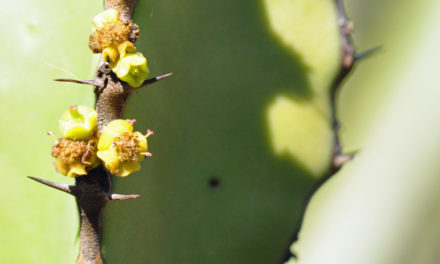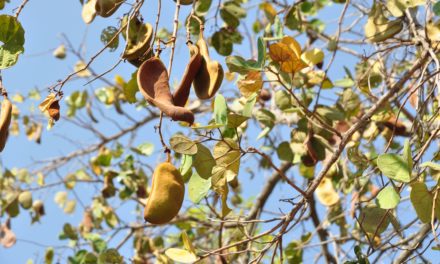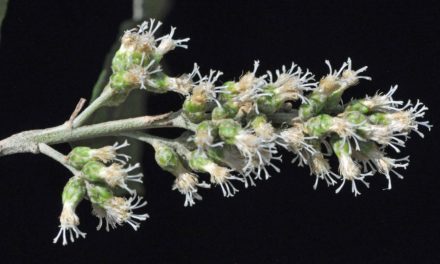General Info – summary
The usually erect, deciduous Tree is up to 18+m high. Trunk bark is rough with single downward pointing spines each on a base. Branches have short, paired curved spines. The bipinnate Leaves have the biggest Senegalia leaflets. Stipules are not spinescent. Many exerted stamens display the white Flowers in long spikes with late developing exerted styles. Fruit a dehiscent, brownish hairless pod + flattened seeds.
Description
Senegalia nigrescens
Previous Names: Acacia nigrescens, Acacia pallens, Acacia passargei.
SA Tree No. 178.
Common names: (Afr) Geelhaak, Knopdoring, Knoppiesdoring, Merrietet, Perdepram, Perdepramdoring. (Eng) Knob Thorn, Knobby Thorn, Knob-thorn. (IsiNdebele) Umhlope. (isiZulu) Isibambampala, Umbambampala, Umbhebhe, Umkhaya. (Northern Sotho) Mokgalô, Moku, Mongana-mabele, Moritidi. (Setswana) Mokala, Mokgwa, Mokoba, Mokôba, More o mabele, More-omabêlê. (siSwati) Umhlofunga, Umkhaya. (Tshivenda) Mudhaya, Munanga. (Xitsonga) Nkayi.
Fabaceae, or Leguminosae (Pea, bean or legume family). After the Orchidaceae and the Asteraceae, the Fabaceae is the third largest Angiosperm (flowering plants) family with 700+ genera and close to 20 000 species. Local Tree genera on this website include Acacia (Vauchellia, Senegalia), Albizia, Bauhinia, Bolusanthus, Burkea, Calpurnia, Colophospermum, Cordyla, Cyclopia, Dichrostachys, Erythrina, Erythrophleum, Faidherbia, Indigofera, Mundulea, Peltophorum, Philenoptera, Piliostigma, Schotia and Xanthocercis. The Fabaceae are recognisable by their fruit and by their pinnately compound Leaves. Leaves may also be simple – even bilobed and usually have stipules – some of which may be spinescent. Leaflets are usually entire. Flowers are bisexual and bracteate. Regular flowers usually have 4-5 sepals and the same number of petals. Irregular flowers have 4-5 sepals and 5 or less petals. Stamens have anthers that have 2 pollen sacs and there are usually at least twice the number of stamens as petals – often 10. The superior Ovary has one locule that may contain 1 or more ovules. The Stigma and Style are simple. The single carpel develops into the Fruit, which is usually a pod. This pod dehisces on both sides and may break into segments. Seeds vary.
Name derivation: Species of the genus Vachellia and Senegalia were considered members of the genus Acacia until 2005. New Names. The genus Vachellia was named after George H. Vachell (1789 – 1839), chaplain and plant collector in China. Here the inflorescence is capitate (head like) and spinescent stipules are present. Plants in the genus Senegalia – (from Senegal) usually do not have spinescent stipules and the inflorescence is usually a spike. nigrescens – becoming black. This may refer to the mature pods.
Conservation: National Status: L C. (Least Concern). Assessment: 2005 (W. Foden and L. Potter).
Tree
This usually upright Tree is frequently up to 18m high but may reach 30m. It has a spreading to rounded Crown (photo 647). In young plants, the crown is often cylindrical. The cylindrical Trunk may reach up to 76cm wide. In very dry areas, this plant may be reduced to a small shrub. The very rough Bark is dark grey to brown, reddish brown or even blackish (photo 95). Longitudinally fissures develop and a reddish under-bark becomes visible (photo 646). A distinguishing characteristic is the single hooked downward pointing Spines that occur on conical, raised knob-studded young trunks (photo 95 & 532). These are similar structures to those in Senegalia burkei but here they are more frequent. Large, older trees have fewer, or no, single spines. Branches usually develop high up and tend to be ascending. Young Branches are usually yellowish and flaky. Small-paired, sharp, hooked Spines are on branches just below the nodes (photo 572 under Flowers). They are hooked and up to 7mm long. Light coloured Lenticels (usually raised corky elongated areas on the plant that allows the uncontrolled interchange of gases with the environment) are present on youngish branches (photo 91).
- 647. 2014/10/30. Pretoria NBG. Photo: David Becking.
- 95 2014/09/02 Mapungubwe NP. Photo: David Becking.
- 646. 2014/10/30. Pretoria NPG. Photo: David Becking.
- 532. 2016/11/15. Pretoria NBG. Photo: David Becking.
- 91. 2014/09/02. Mapungubwe NP. Photo: David Becking.
Leaves
This deciduous tree is leafless for several months during winter and early spring. The Leaves are up to 14cm long (usually less) and are bipinnate (compound: twice-pinnate leaves. The rachis – central axis, has lateral pinnae “branches” not leaflets and the pinnules “leaflets” are on these “side branches”). Small-recurved spines are present on the rachis (photo 105). There are relatively few pinnae 1-4 pairs (photo 469) – each bearing only 1 or 2 pairs of asymmetric Leaflets (photo 105). The distinctive large leaflets (photo 892) are pale to grey-green above and slightly lighter below (photo 892). Leaflets are often nearly circular and up to about 3 x 3cm. They are the largest of the Vachellia or Senegalia leaflets. Midrib and veins may be distinctive (photo 105) and glands may be present at the base of pinna, and sometimes on the Petiole (leaf stalk). The petiole is up to 5,5cm long and may be hairy. The petiole and rachis may be pinkish on the side facing the sun. The bases of the petiole and the Petiolule (stalk of leaflet) may be swollen (photo 105). The linear Stipules (basal appendage of the petiole) are not spinescent and soon fall.
- 892. 2017/03/01. Pretoria NBG. Photo: David Becking.
- 105. 2014/09/02. Mapungubwe NP. Photo: David Becking.
- 469 2014/09/10 Marloth Park. Photo: David Becking.
Flowers
Flowering occurs in spring but is usually erratic. The open flowers give rise to an impressive creamy white display, which may cover the whole tree (photo 216). The sweet scented Flowers occur in elongated Spikes (simple indeterminate inflorescences with sessile flowers on a single unbranched stalk) that are from 7 to 10cm long (photo 572). Each spike rests on a Peduncle (stalk of flower cluster). These spikes are clustered at nodes (points on a stem where the buds, leaves, and branching twigs originate. The space between 2 nodes is the internode – photo 572). Within each spike, the individual small flowers are bisexual and actinomorphic (Regular, symmetrical. Flowers are vertically divisible into similar halves by more than 1 plane passing through the axis). When the pink flower Buds (photo 659) occur in noticeable large numbers, these sepals (photo 572) give the tree a reddish tinge. Here the red Peduncles (stalks of flower cluster) are visible. The glabrous (hairless) Calyx has short Sepals that are initially pink or red/brown (dissected spike photo 665) and are visible before the flowers open. Flowers often open before the new leaves appear. The glabrous Corolla is up to 2,5mm long (Photo 665). In this photo, the filaments are straight and no style is visible. The exserted (sticking out – projecting beyond) Stamens have white Filaments and are mainly responsible for the open flower colour. Their Anthers (photo 665) dehisce longitudinally. There is a single Pistil (the female element of the flower composed of the ovary, style and stigma) and its Ovary is superior (said of an ovary that is free from the calyx or perianth) and contains one locule (compartment). The filiform (thread or filament like) Style extends beyond the anthers once the pollen has been shed (phot0 445). The style ends with a small, terminal, concave Stigma. Transition from pre (photo 655) to post (phot0 445) pollen shedding is clearly visible in these 2 photos. In photo 445, the styles are extending beyond the declining stamens. This process helps prevent self-pollination. (Aug-Nov). Insects are the pollinating agents. (Aug-Oct).
- 216. 2017/09/19. Pretoria NBG. Photo: David Becking.
- 572. 2016/08/23. Pretoria NBG. Photo: David Becking.
- 659. 2017/08/29. Pretoria NBG. Photo: David Becking.
- 665. 2017/08/29. Pretoria NBG. Photo: David Becking.
- 445. 2016/11/08. Pretoria NBG. Photo: David Becking.
Fruit
The straight, flattish, olive to dark brown or black Fruit is a hairless Pod that narrows at both ends and hangs down (photo 821). Each pod (photo 570) is up to 17 x 2,5cm and is straight or nearly so. It is rather thinly textured, hairless, dehiscent or indehiscent with the remains of the calyx visible at the base (photo 821). On this photo, the Veins are prominent. Seeds are compressed (photo 578) and are up to 1,3 x 1,3cm. Here the Funiculus (the stalk by which the ovule/seed is attached to the ovary wall or placenta) and the U-shape on the seed are visible (photo 73). (Nov-Jul).
- 821. 2018/02/12. Pretoria NBG. Photo: David Becking.
- 570. 2016/08/23. Pretoria NBG. Photo: David Becking.
- 98. 2014/09/02. Mapungubwe NP. Photo: David Becking.
- 578. 2016/08/23. Pretoria NBG. Photo: David Becking.
- 73. 2018/08/17. Pretoria NBG. Photo: David Becking.
Distribution & Ecology
These Trees are sought after by hole-nesting birds, and occur naturally in low altitude bushveld and savanna but not on sandy soil. They are common in the drier parts of the lowveld (land areas that lie at an elevation of between 150 and 600m and occur in parts of North West, Kwazulu-Natal and Mpumalanga). They may be the only tree in some areas and may even form pure stands. The tree is often found near watercourses, in heavy soils and may be the dominant tree in floodplain woodland. Trees may occur in grassland with Themeda triandra (red grass). This tussock-forming grass is good for grazing. They occur naturally in Gauteng, Limpopo e.g. in Mapungubwe and in Mpumalanga e.g. in the KNP near Punda Maria and between the Olifants River and Satara. Trees also occur between Skukuza and Pretorius Kop – where they occupy black turfy soils derived from dolerite (a dark, medium-grained igneous rock, which typically occurs in dykes and sills). Trees grow on both sides of the Lebombo Mountains, (which extend from Hluhluwe in KwaZulu-Natal through Swaziland, and Mozambique to Punda Maria in Mpumalanga). Beyond South Africa, they occur in Swaziland, southern Zimbabwe, eastern Botswana, and Northern Namibia including the Caprivi Strip, Zambia, Malawi and Tanzania. Generally, they are considered as indicators of good grazing. Trees are fire and drought-resistant but susceptible to frost. Animals including giraffe, monkeys, baboons and elephant eat the Pods. Monkeys, giraffe and baboons eat the Flowers. Kudu, duiker, impala, steenbok, giraffe and elephant eat the Leaves. The leaves serves as a host plant for butterfly larvae of the Demon Emperor Charaxes phaeus. (These larvae also feed on Tamarindus indica (also a member of the family Fabaceae. This tree is a naturalized exotic that produces excellent fruit). The larvae rest on the upper surface of a leaf on which they have spun a protecting silk pad. Leaves produce chemicals that retard seed germination. This ensures survival when tree dies. It also contributes to the similar Tree ages in tree groups. Trees are often nesting sites for Birds like hornbill, glossy starling, hoopoes, parrots, rollers and barbets. The Pearl-spotted owlet (Glaucidium perlatum) and the very small (up to 17cm long and a wingspan of 45cm) African scops owl (Otus senegalensis) often frequent the trees.
Ethnobotany
The termite resistant, dense Wood is very hard, difficult to saw and is used to make fighting sticks. Sapwood is a light cream coloured and the heartwood is dark brown (photo 172). It is difficult to saw but is also used to make fence poles, furniture and mine-props. Wood has a high impact toughness and is good for parquet flooring. The wood is also used for fuel and produces good quality firewood, which burns at a high temperature with relatively little smoke. Trees grow about 0,5m or less per year but are frost sensitive. The small gentle-looking Leaves have hooked thorns on the rachis and petiole. These may become a problem when handling. The Bark contains a lot of tannin and is useable for tanning. This is a good shade tree and can be Grown from seeds. These should first be soaked in hot water overnight before planting. The seedlings should be planted in full sun and are relatively slow growing. The plant is used for bonsai.
- 172. 2019/08/13. Skukuza Nursery. Photo: David Becking.
References
Boon, R. 2010. Pooley’s Trees of eastern South Africa. Flora and Fauna Publications Trust, Durban.
Burrows, J.E., Burrows, S.M., Lotter, M.C. & Schmidt, E. 2018. Trees and Shrubs Mozambique. Publishing Print Matters (Pty) Ltd. Noordhoek, Cape Town.
Bryant, C. Lombo, B. 2004. Trees of CC Africa, Double Story Books, Cape Town.
Coates Palgrave, M. 2002. Keith Coates Palgrave Trees of Southern Africa. edn 3. Struik, Cape Town.
Foden, W. & Potter, L. 2005. Senegalia nigrescens (Oliv.) P.J.H.Hurter. National Assessment: Red List of South African Plants version 2020.1. Accessed on 2023/12/24.
Ginn P.J. Mcilleron W.G. and Milstein P. le S, 1989. The Complete Book of Southern African Birds. Struik, Cape Town.
Lawrence, G. H. M, 1951. Taxonomy of Vascular Plants. The Macmillan Company, New York. Tenth Printing 1965.
Palmer, E. & Pitman, N. 1972. Trees of southern Africa. Balkema, Amsterdam, Cape Town.
Schmidt, S. Lotter, M. & McCleland, W. 2002. Trees and Shrubs of Mpumalanga and the Kruger National Park. Jacana, Johannesburg.
van Wyk, B. & van Wyk, P. 1997 Field guide to Trees of Southern Africa. Struik, Cape Town.
https://en.wikipedia.org/wiki/Senegalia
http://www.plantbook.co.za/senegalia-nigrescens/
http://www.krugerpark.co.za/africa_knob_thorn.html
http://pza.sanbi.org/senegalia-nigrescens
http://iscantree.co.za/senegalia-nigrescens-knoppiesdoring-knob-thorn/
http://growwild.co.za/trees/senegalia-nigrescens-acacia-nigrescens

